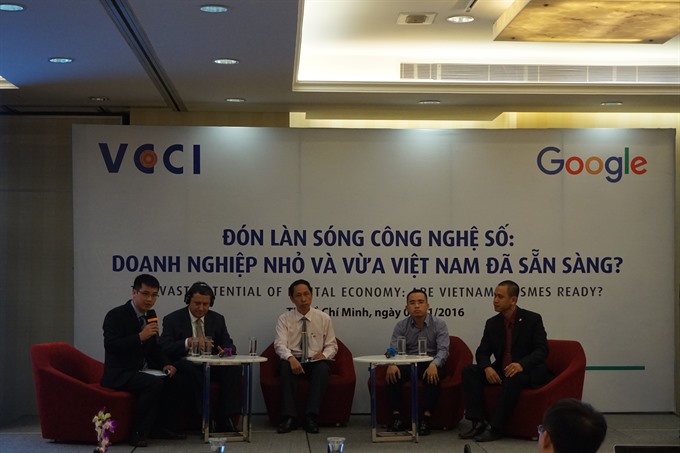 Economy
Economy

Vietnamese firms, especially small- and medium-sized enterprises, should take advantage of the power of digital technology to boost sales and improve competitiveness, delegates said at a workshop held in HCM City yesterday.
 |
| A panel discussion at the workshop “Tapping Vast Digital Economic Potential: Are Vietnamese SMEs ready?” held in HCM City on November 2. — VNS Photo |
HCM CITY — Vietnamese firms, especially small- and medium-sized enterprises (SMEs), should take advantage of the power of digital technology to boost sales and improve competitiveness, delegates said at a workshop held in HCM City yesterday.
Việt Nam has a high growth rate of internet penetration, with 52 million internet users or more than half of the population.
The number of internet users is expected to reach 82 million by 2020, according to Tammy Phan, head of Channel Sales in Việt Nam of Google Asia-Pacific.
Eight out of every 10 Vietnamese are expected to be using a mobile phone by 2020, said Phan.
The internet has transformed many aspects of daily life in Việt Nam, including the way consumers interact with businesses.
Before making purchasing decisions, 70 per cent of internet users search for information and shopping addresses, and 66 per cent conduct research one day before going to shops to see products.
The number of SMEs using digital technology to promote their products and access potential customers remains modest, as only 20 per cent of SMEs in Việt Nam had online sale channels, according to Phan.
A survey conducted by the Việt Nam Chamber of Commerce and Industry (VCCI) of 10,000 SMEs showed that digital technology has had a tremendous impact on Vietnamese businesses.
Đậu Anh Tuấn, head of VCCI’s legal department, said the use of internet among SMEs increased significantly in the past decade, with 95 per cent of businesses using the internet last year. But nearly 60 per cent of them reported ineffective use of information technology.
Businesses with effective IT applications have easier access to information about the Government’s policies and laws and are able to comply with administrative procedures more quickly. They also have better business performance, he said.
Matthew Heller, head of Channel Sales at Google Asia Pacific, said: “Study after study shows that small businesses do better when they establish a strong web presence. They can grow sales up to four times faster than their offline competitors when they embrace the web and digital tools, especially on mobiles.”
Võ Tân Thành, director of VCCI’s HCM City branch, said that digital technology was having a significant impact on all business sectors, so applying these technologies was a must for SMEs.
To capitalise on opportunities and challenges from international integration, Việt Nam should carry out many measures, including the development of technology infrastructure and speeding up of IT application at both State agencies and businesses.
“In order to fuel the development of Vietnamese SMEs, the Government needs to create good policies and work with the private sector to create technology infrastructure platforms, and most importantly, Vietnamese businesses must be more proactive in applying digital technologies,” Thành said.
Trần Vĩnh Tuyến, deputy chairman of the HCM City People’s Committee, said that authorities aimed to turn HCM City into a “smart city”, and needed businesses’ assistance to help set up e-government or map out measures to help the city prevent flooding and traffic congestion.
Also at the event, two local SMEs – Always, a health and beauty retailer and distributor, and HV Net, a marketing company – spoke about finding success online and how digital technology helped them achieve higher sales.
Organised by VCCI and Google Asia Pacific, the workshop on “Tapping Vast Digital Economic Potential: Are Vietnamese SMEs ready?” was one among a series of activities carried out by VCCI to promote the development of SMEs.
SMEs account for 97 per cent of the business community and contribute 40 per cent of the country’s GDP. — VNS